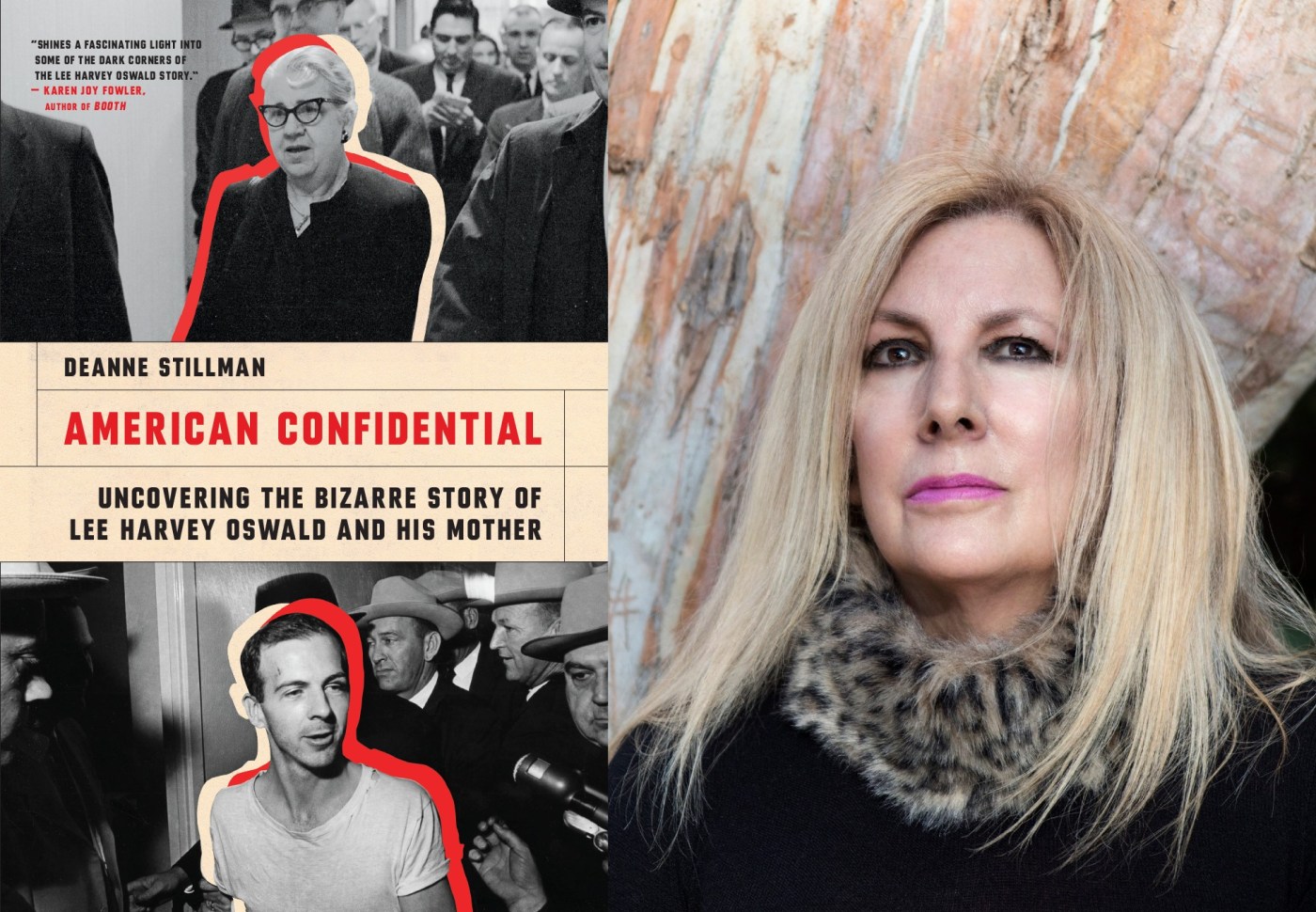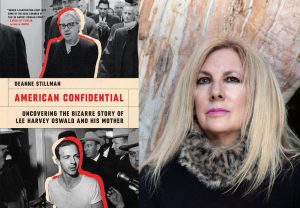
How ‘American Confidential’ explores JFK assassin Lee Harvey Oswald and his mom
This November 22 will mark 60 years since President John F. Kennedy was gunned down in Dallas – an event that not only terrorized a nation and inspired the 25th Amendment to the Constitution, but spawned a vast body of literature about the murder and its meaning in American life.
Now Los Angeles-based author Deanne Stillman shines a light into a little-known corner of this tale with “American Confidential: Uncovering the Bizarre Story of Lee Harvey Oswald and his Mother,” publishing Nov. 7 from Melville House.
Stillman is best known for her evocative nonfiction that explores brutal histories in the West, with such titles as “Twentynine Palms: A True Story of Murder, Marines and the Mojave,” “Mustang,” “Desert Reckoning” and “Blood Brothers: The Story of the Strange Friendship Between Sitting Bull and Buffalo Bill.”
“American Confidential” continues Stillman’s oeuvre exploring the dark side of the American psyche. It delves into the troubled life of a man who, she argues, was the prototype of the disturbed “lone gunman” behind current mass shootings. But it also examines the peculiar and powerful dynamic between Oswald and his mother, Marguerite, who seemed consumed by a need to matter and was fueled by resentment toward society.
Stillman says she has been “reading and thinking about” the JFK assassination for years, and waded through thousands of pages of conspiracy coverage and testimony before investigative commissions to “find things that were of interest to me regarding Oswald’s family coming from family members themselves. That’s where the keys are buried and revelations are to be found.”
Recently, I emailed with Stillman, whom I have known since “Twentynine Palms” entered the zeitgeist in the ’00s. Here’s our exchange, edited for clarity and space:
Q. Why does this event continue to capture our collective imagination?
Oswald was like Brutus, the assassin of Julius Caesar, or even Pontius Pilate, who ordered Christ’s killing. Killing JFK was a betrayal of tremendous magnitude, not that Oswald knew Kennedy or was in his orbit, like the others, but it was an act of unfathomable treachery, a shot in the heart of the country, it shattered all manner of checks and balances.
It has also led to a wave of conspiracy theories without end – and given that the government was lying at the time about Vietnam and many other things, that was understandable – but this ongoing conspiracy madness regarding any consequential thing that happens is now destabilizing the country. When it comes to Oswald, Norman Mailer, whose book “Oswald’s Tale” informed mine, has said that people couldn’t believe that a figure who mattered little, a cipher like Oswald, could take down JFK, a man of great stature and value. This guy? You gotta be kidding me. Yeah, this guy.
In my view, there was what I call an inadvertent “conspiracy of one,” formed by Lee and his mother together, in a desperate and inadvertent campaign to matter. So in the end, Oswald is Travis Bickle [the main character in the movie “Taxi Driver”], posing with his rifle for a Polaroid taken by his wife, essentially saying, “You talkin’ to me? Ma, do you see me now?”
Q. As you note in the book, it is thought that the assassination of JFK has been written about more than any other single day in history, including more than a thousand books and innumerable essays and articles. There have only been a few that concentrated on Oswald and his mother’s unique and seemingly toxic relationship. What more did you feel needed to be uncovered?
Actually, there’s just one that’s about Oswald and his mother Marguerite, not counting mine, and that’s called “A Mother in History” by Jean Stafford and like most of the other major books on the JFK assassination, it came out decades ago. It was foundational to “American Confidential,” and just one of two of the many about the assassination written by women, not counting mine.
What is missing from all of these books is a placement of the Oswalds in a deep cultural context, in the way that I like to look at things. For instance, buried in most of the coverage is the information that Marguerite Oswald’s father was a streetcar conductor in New Orleans. What streetcar exactly? I started to wonder and as I looked into this thread – and bear in mind that we’re talking about Lee’s grandfather – I realized that for various reasons, he was probably a conductor on the Desire line, immortalized by the Tennessee Williams play, “A Streetcar Named Desire.” And then I started thinking about how that echoed in the Oswalds’ life. The play is about a family of little means brutalized by Stanley Kowalski (Marlon Brando in the movie) and the more I thought about this, the more I knew that there were parallels to what was going on between Lee and his wife, the beatings and emotional violence, as I recount in my book, who lived in shabby apartments in New Orleans and elsewhere.
There was also the fact that Lee loved riding the subway while he and his mother lived in the Bronx. He carried maps and marked out routes and spent a lot of time riding those rails. I suggest that this was possibly a way of connecting with his grandfather, who died before Lee was born; most likely, he had heard tales of his service on the Desire line, which went right past their house.
Also, I realized that Marguerite had grown up during the Depression – something that I haven’t seen explored elsewhere – and in particular, during the time of Huey Long, the populist demagogue who was governor of Louisiana, a smarter precursor of Donald Trump. His famous slogan was “Every man a king, every woman a queen,” and that was all about the fact that many in the country were destitute.
Marguerite herself worked a series of menial jobs and was a single mother with three sons. One of her jobs was as a greeter for the Fort Worth Welcome Wagon in the 1950s. I placed her in such a scene, recreating what this task entailed and the desperation of a woman who would never be welcomed anywhere – and she knew it. Her class resentment festered over the years and she passed it on to Lee, who defected to the “worker’s paradise” of Russia, then saw that workers were being exploited there as well, and returned with a deep need to take down the king. And this was JFK. The focus on conspiracies in most other coverage has led people far afield from this central truth about the Oswald family.
Q. What other realizations did you have about Lee while researching this book?
In my view, Lee foretold the mass shooters of today. [“Taxi Driver” director] Martin Scorsese recently said that nowadays, there are many Travis Bickles. This is what I say in my book. In a way, it all started with Oswald; the famous image of him with his rifle is not unlike Bickle in front of the mirror with his. It should be noted that Artie Bremer, who tried to assassinate Alabama governor George Wallace in 1972, cited Oswald in his diaries, and he was the inspiration for Travis Bickle. Since then, some of today’s mass shooters have also referenced Oswald, and many now pose for selfies with their weapons just before they go on a rampage or stream it live.
Q. Another recent book, “The Final Witness” by Paul Landis, suggests Oswald was indeed part of a conspiracy. Does that matter to you?
Yes, it does. It will be interesting to see if this new book by a former Secret Service agent, which throws “the magic bullet” theory into question results in a new appraisal of what happened. But I think what we know for a fact still points to Oswald as the lone assassin. After killing JFK and fleeing, he killed a cop who confronted him in the streets, and then – and this isn’t something that is often talked about – he tried to kill one of the cops who was trying to arrest him in a movie theatre where he was hiding. Had he succeeded, it would have been his third murder of the day. All of that speaks for itself and certainly is not the behavior of an innocent man.
Q. Throughout the book, you allow yourself to imagine dialogue and what people might have been thinking. Can you talk about the role you feel a writer’s imagination has in reporting nonfiction?
Related Articles
5 do-ahead recipes for your Thanksgiving feast
6 ideas for a Wonka dream vacation this winter
The best airlines for 2023 holiday travel on points
Mazda shows off the 2023 MX-5 Miata nicely
Holiday slasher ‘Thanksgiving’ serves up killer spread
I bring speculation into all of my books, as well as elements of fiction, such as how people are shaped by interior and exterior landscapes. Sometimes fiction is the only way to tell the truth, especially when the moment-to-moment facts about a particular scene aren’t known. I often imagine scenes involving my characters, as if they are in a play, which they are. In this story, such scenes are informed by how Lee and Marguerite talked, which I knew from reading many accounts including first-person statements to investigators and conversations with those around them. Place is also an element, as it always is in my work. Here we have New Orleans, Fort Worth, the Bronx, and Dallas where Oswald and his mother lived. I think they moved about 22 times by the time Oswald was 17. I wanted to take a look at how certain locations informed Lee’s life, and this hasn’t been written about elsewhere. Fort Worth – its slogan “Where the West Begins” – is a key element here.
Q. What do you hope readers take away from “American Confidential”?
I never second-guess readers, but I would like people to stop dividing the question of gun violence in this country into one or another answer. We need to talk about what goes on in families and pathologies that are created and what happens when unfettered access to guns is thrown into the mix. We are now at an impasse – and we have just had another mass shooting.

